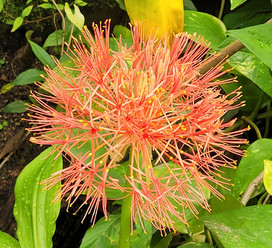Make sure to read this whole article and watch the accompanying videos. There are so many interesting tidbits of information I found when researching the Krohn Conservatory and Eden Park. I’ve been visiting these places all my life and never knew their history.

One of the traditions of spring, in Cincinnati, is the Butterfly Show at the Krohn Conservatory in Eden Park. It runs mid-March through mid-June. Every year they pick a different region of the world to give visitors the opportunity to experience exotic butterflies from places they may not get to travel to. The 2022 Butterfly Show hosts butterflies of the Nile. The design of the exhibit reflects a typical Ancient Egyptian garden featuring orchards, palms and fish ponds with lotus plants.
According to Manager Mark House, "The butterflies are raised by farmers all over the world. They package themselves in chrysalis. Butterfly farmers collect them, put them in a box and overnight ship them to us. So we are ready every Tuesday and Friday to receive those packages, usually from FedEx or UPS. We take the chrysalis out and we put them in containers and we allow the butterflies to emerge. And once the wings are dry and they're able to fly, we put them on a little taxi and we bring them into the room and we release them around 11 o'clock each day."
While we were there, one of the butterflies flew into the pond. You can't actually see what happened but you can figure out what happened next by the children's reactions. Not something they will soon forget.

Exhibited at the Butterfly Show this year are sculptures by internationally acclaimed artist, Dominic Benhura, from Zimbabwe. https://www.dominicbenhura.com/
The Krohn Conservatory
The Krohn Conservatory, originally known as Eden Park Greenhouse, was built in 1933 replacing smaller greenhouses that had stood in Eden Park since 1894. In 1937 it was renamed in honor of Irwin M. Krohn, who served as Board of Park Commissioner from 1912 to 1948.
The conservatory was designed by the architectural firm Rapp & Meacham in the Art Deco style in the form of a Gothic arch. It opened in 1934, with an impressive attendance of over 300,000 visitors that year.
In 1966, a hailstorm caused extensive damage to the conservatory. The firm of Lord & Burnham were contracted to restore it. At that time, the original wooden sashes were replaced with durable aluminum.
The Krohn Conservatory is home to six unique collections:
Bonsai Collection – a collection of bonsai trees from the Conservatory itself, the Bonsai Society of Greater Cincinnati, and private individuals.
Desert Collection – a variety of cacti and succulents that are all native to the desert.
Floral Collection – home to six seasonal floral shows. (Currently the Butterfly Show)
Orchid Display – a collection of approximately 75 blooming orchids at any time.
Palm Collection – a 45-foot high central house with rubber trees, palm trees, shrubby plants, a waterfall, and a goldfish stream.
Tropical Collection – a large variety of ferns.
Ever wonder why Krohn Conservatory always looks painted white or has dirty looking windows?
The windows look dirty purposefully. Otherwise the temperatures would get up to 140° inside and kill the plants. Every spring whitewash is applied to the building to help protect the plants from sun damage. It reflects the ultraviolet light that heats up the building keeping it cool and maintaining the temperature. The white latex paint, which is benign and environmentally friendly, is applied with a tall bucket truck and takes one day to apply. There is an additive in the paint that causes it to come off the glass when it snows or freezes allowing the ultraviolet light to go through the glass and keep the conservatory warm in the winter. -Mark House, Krohn Conservatory Manager
Eden Park
The park’s current location was once owned by Nicholas Longworth, a famous Cincinnati landowner who used the area as a vineyard and named the estate “the Garden of Eden” in honor of the biblical Garden of Eden. In 1869, the city of Cincinnati purchased the land from Longworth and kept the name “Eden” for the park. Eden Park Spans almost 190 acres.
Mirror Lake
We had a packed lunch at Mirror Lake before going to the Butterfly Show. Mirror Lake is a reflection pool located at 950 Eden Park Drive. The pool includes a fountain that shoots water 60 feet into the air. Currently the lake is empty due to ongoing repairs but it was still a nice lunch in the park with friends.
What is the history of Mirror Lake and what lies beneath it?
In the 1870s, the city built a 12-acre reservoir on the property. Water was pumped from the Ohio River into the dam and subsequently into the Eden Park Stand Pipe by Eden Park Station No. 7.
In the 1960s, the system needed to be updated. The eastern reservoir was discontinued and Mirror Lake was built on top of the western reservoir to keep debris out of the water and protect a major source of Cincinnati’s drinking water. Eden Park Station No. 7 and the Eden Park Stand Pipe, and a portion of the original reservoir dam wall remain in the park today.
Springhouse Gazebo
The Springhouse Gazebo, next to Mirror Lake, sits on top of a fresh water spring. The gazebo was constructed in 1904 and is the oldest enduring park structure in the entire Cincinnati Parks system.

Twin Lakes
Twin lakes was the site of an abandoned limestone quarry. The stone quarried from the site was used for all the retaining walls and many of the building foundations in Cincinnati. The Twin Lakes area features a footbridge traversing the adjoining lakes.

About half of the buildings in the park like the restroom and concession stand, near the Twin Lakes, were part of the WPA. These Federal Works projects helped put Cincinnatians back to work during the great depression.




























































































Comments